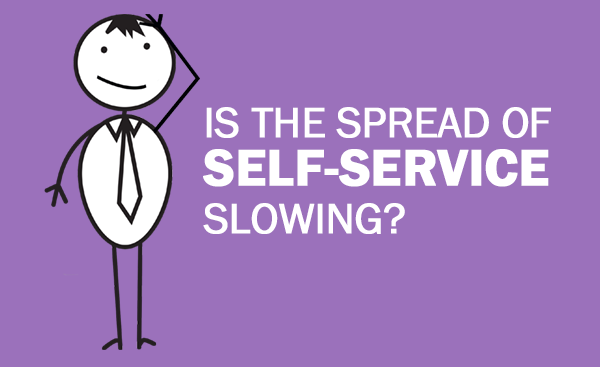Is the spread of self-service slowing?

In 2011 Gartner predicted that by 2020, 85% of customer relationships would be run without human intervention. At the time it seemed a startling target, but in just four years self-service has become the norm for many transactions. For example, how many of us actually phone or visit a bank branch? And if we do, it tends to be just to pay in or take out money through a machine. It is the same in other industries – we can check and download our utility bills online or buy holidays and flights without speaking to a travel agent.
In our time-precious lives, consumers value the speed and flexibility of being able to do something themselves. This is backed up by research from Amdocs that found that 75% of consumers would rather use online self-service compared to calling a contact center. However a new study by ThinkJar analyst Esteban Kolsky states that businesses are not fully embracing digital self-service. Only 56% of organizations polled had a self-service initiative underway, with 93% agreeing they had a lot to learn when it came to offering a better self-service experience.
To achieve Gartner's targets, and deliver the benefits of self-service to both consumers and themselves, companies need to adopt a more holistic, multichannel approach to self-service, Kolsky argues.
So how can companies achieve this? Based on our experience we believe there are five areas to focus on to ensure self-service improves customer engagement:
1. Join it up
As Kolsky says, self-service needs to be multichannel. And that means sharing knowledge across different channels, so that information is consistent, however the consumer makes contact. Ensure you have a centralized knowledgebase that underpins all of your customer service channels in order to deliver this. It also helps bring down costs, as you don’t have to invest in building and maintaining multiple silos of information across your organization.
2. Make it visible
Customers want self-service so don’t hide it away. Ensure that links to self-service systems are easy to find, with visible search boxes that encourage people to ask their questions. Some companies brand their self-service system and give it a personality and name in order to increase its appeal to consumers across all demographics. It is also important to make it open to everyone – some organizations only let existing customers ask questions, shutting the door on new business by not allowing prospective customers to engage.
3. Cost should not be the primary motivation
Installed correctly, self-service systems will bring down costs as consumers will be able to find answers without needing to use more expensive channels such as the telephone. However companies need to look beyond cost savings and focus on the overall customer experience. They need to consider how easy self-service systems are to use by consumers, how regularly information is updated, how well they link to other channels and how they reflect overall brand values. Implemented correctly, self-service systems will increase efficiency, but if they are hard to use or fail to provide fast answers consumers will simply go back to more expensive channels.
4. Make escalation seamless
Even the most powerful self-service system cannot answer every consumer question. Certain queries will involve personal information or will be more complex and will need the involvement of a human. So make it simple to escalate from self-service to personal service, with the option of emailing, opening a chat window or providing a phone number to the consumer. Keep a record of what they have asked already, so they don’t need to repeat themselves when they interact with an agent – nothing annoys a customer more than having to ask the same thing multiple times.
5. Innovate
Self-service is now a relatively mature technology, with over half (53%) of companies surveyed last year in the Eptica Multichannel Customer Experience Study having deployed it on their websites. Innovative companies are therefore looking at how they can extend self-service to other channels, whether through Facebook portals, mobile apps or by using the Internet of Things to allow devices to automatically log faults and repair themselves without human intervention. The rise of technologies such as wearables also offers new opportunities for self-service to spread, as do more intelligent linguistic-based systems that can understand the tone of incoming interactions and take corresponding automatic action.
Gartner’s prediction may have seemed far-fetched when it was announced, but the benefits of self-service continue to grow, meaning that the target is still very much achievable. To be successful organizations therefore need to focus on how they can deploy self-service and use it to improve the experience and deepen engagement with their customers.






